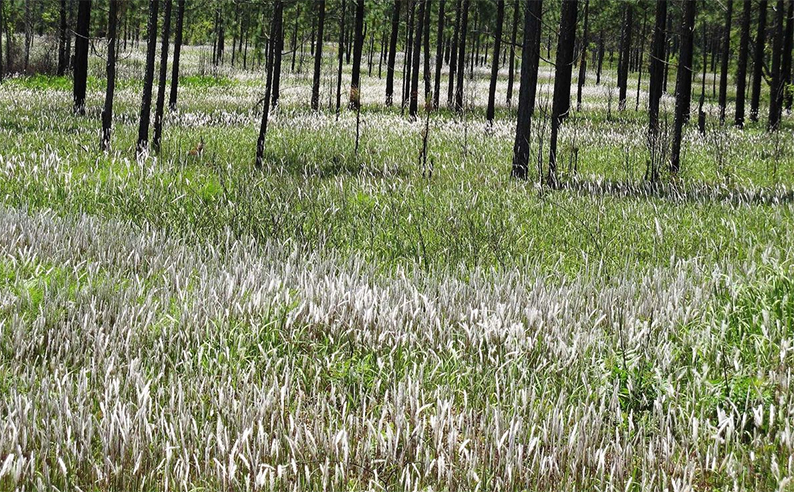In the serene tapestry of nature, where lush green lawns and native plants coexist, there lurks a silent threat – cogongrass. This invasive species, designated as a “noxious weed” by federal authorities, poses a grave danger to ecosystems across the United States. While it once confined its reach to the southeast, cogongrass is now spreading its insidious influence, compelling the U.S. Department of Agriculture (USDA) and other agencies to seek the public’s assistance in halting its advance. This article dives deep into the world of cogongrass, its menacing characteristics, and how you can help prevent its proliferation.
Understanding Cogongrass
Cogongrass, scientifically known as Imperata cylindrica, goes by various aliases such as cogon grass, Japanese bloodgrass, and Red Baron grass. It was introduced to the United States, specifically Alabama, in 1911, likely arriving in packing material from Japan. However, its origins matter less than its devastating impact on local ecosystems.
This invasive plant has earned its noxious reputation by being harmful to public health, agriculture, recreation, wildlife, and property. In fact, the USDA ranks it as the “seventh-worst weed in the world.” Cogongrass possesses the ability to form dense, choking patches, stifling the growth of native plant species, and crops, and even reducing forest productivity. The ripple effect is catastrophic, leading to the destruction of precious wildlife habitats.
Cogongrass’s Expansion and Reach
Cogongrass’s stronghold was initially in Alabama, Mississippi, and Florida. However, it has aggressively expanded its territory, spreading through Virginia, North Carolina, South Carolina, Georgia, Tennessee, Louisiana, Texas, and Oregon. The alarming trend doesn’t stop there; it has even been identified in states like Vermont, Minnesota, and as recently as May 2022, Idaho. This relentless spread is facilitated by cogongrass’s adaptability, as it ventures into colder regions, thanks in part to the warming effects of climate change.
Identifying Cogongrass
To effectively combat cogongrass, you must first be able to identify it. The invasive species possesses distinctive characteristics, making it stand out amidst native vegetation. Look out for these telltale signs:
- Leaves: Cogongrass features green or red leaves, approximately 1″ wide, with sharp edges. Red leaves classify it as Red Baron grass or Japanese bloodgrass.
- Flowers: The plant produces white, plume-like flowers that are visually distinct.
- Seed Heads: These white, fluffy structures appear in the spring, another recognizable feature.
- Height: Cogongrass typically grows to a height of 2 to 4 feet.
- Growth Pattern: It forms circular formations in areas with full sunlight or partial shade.
To assist in identification, consider referring to resources such as the Alabama Forestry Commission’s informative video guide.
Halting the Cogongrass Onslaught
If you’ve identified cogongrass in your vicinity, swift action is crucial to prevent its further spread. Here’s a concise guide on what to do and what to avoid, according to the Center for Invasive Species and Ecosystem Health, a partnership between the USDA and the University of Georgia:
- Contact Authorities: Reach out to your local Forestry Commission Office or county extension office as soon as possible. Early intervention is key to containment.
- Mowing Precautions: Under no circumstances should you mow through, around, or near areas with cogongrass, especially when it’s flowering and producing seeds. Mowing can inadvertently disperse these seeds, exacerbating the problem.
- Soil Disturbance: Avoid any form of soil disturbance in and around cogongrass-infested areas, which includes digging, raking, disking, grading, and other activities. Soil may contain root fragments that can propagate cogongrass growth in other areas.
- Prescribed Burns: Never attempt prescribed burns in areas hosting cogongrass without obtaining approval from Forestry Commission personnel. Ill-advised burns can worsen the situation.
- Equipment Hygiene: Thoroughly clean all equipment used in or near cogongrass-infested areas. This precaution ensures that no seeds or plant fragments are inadvertently transported to new locations.
Cogongrass, the insidious invader of ecosystems, threatens to disrupt the natural balance of our landscapes. Understanding its characteristics and acting swiftly is the key to preventing its proliferation. By heeding the guidance of local authorities and implementing precautions to avoid unintentional dissemination, we can collectively combat the menace of cogongrass and safeguard the beauty and health of our natural environments. It’s a battle that requires vigilance, but it’s one we must fight to protect the delicate fabric of our ecosystems.

